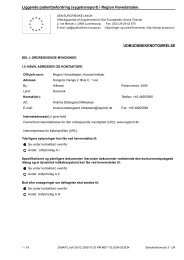Territorial Review Copenhagen - Region Hovedstaden
Territorial Review Copenhagen - Region Hovedstaden
Territorial Review Copenhagen - Region Hovedstaden
You also want an ePaper? Increase the reach of your titles
YUMPU automatically turns print PDFs into web optimized ePapers that Google loves.
84<br />
1.4.4 Urban amenities<br />
Housing<br />
Housing prices in Denmark have risen dramatically since 1995, although<br />
they have fallen by 15% since 2006. Mainly due to population growth,<br />
migration, and low interest rates on loans, housing prices in the Capital<br />
<strong>Region</strong> increased considerably from 1995 to 2006, especially in the northern<br />
and central municipalities. Prices of owner-occupied dwellings in<br />
<strong>Copenhagen</strong> quadrupled from 1997 to 2007 (Figure 1.25) and rose even<br />
higher in such areas as Amager and Sydvestkvarteret (City of <strong>Copenhagen</strong>,<br />
2008). Consequently, residents generally perceive their city as a place where<br />
it is difficult to find good housing at a reasonable price (Figure 1.24).<br />
Affordability may have also been reduced by national factors, particularly<br />
the availability of interest-only mortgage loans in Denmark. Low rates have<br />
allowed average mortgage debt levels to rise throughout Denmark, and the<br />
income needed to service mortgages did not keep pace (OECD, 2005). 28<br />
Currently, the falling prices and the expectation of future price drops have<br />
contributed to a more restrictive lending policy from real estate credit<br />
institutions. Owner-occupied flats constructed during 2006-07 are now<br />
difficult to sell even at reduced prices. The construction of additional<br />
housing will probably be curtailed until developers rent existing stock and<br />
recoup some of their losses. 29 While housing costs have fallen from their<br />
peak in 2006, developers are constrained to construct moderately priced<br />
units, particularly given the impact of global financial turmoil, which is<br />
projected to result in a sharp contraction of housing construction.<br />
Compared to other large cities in the OECD, indicators suggest that<br />
<strong>Copenhagen</strong> homeowners pay a high cost for housing relative to their<br />
income. The ―median multiple‖ constitutes one standard tool to measure<br />
income affordability; it measures the ratio of median house price to the<br />
median household income in a city. The ―median multiple‖ facilitates<br />
comparisons though it is by no means the only affordability indicator in<br />
use. 30 Typically those economies where individuals need over five times<br />
their annual salary to buy a home are ranked ―severely unaffordable‖, which<br />
is followed by ―seriously unaffordable‖ (4.1 – 5.0), ―moderately<br />
unaffordable‖ (3.1 – 4.0), and ―affordable‖ (3.0 or less) (Demographia,<br />
2008). Using this methodology, the area could be characterised as ―severely<br />
unaffordable‖ with high rates in the City of <strong>Copenhagen</strong> (15.0) and Malmö<br />
(10.6). Nevertheless, additional caution is warranted when interpreting and<br />
drawing conclusions from this data. The ―median multiple‖ does not take<br />
into account house and lot size differences despite wide international<br />
variation. 31 This is a critical omission given that the average size of<br />
dwellings in Denmark, averaging 109.6 m 2 per dwelling, is the highest

















